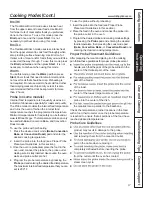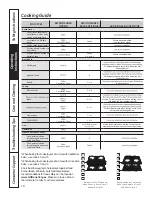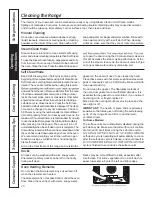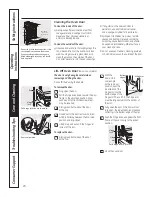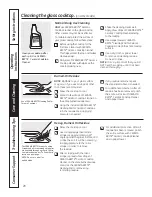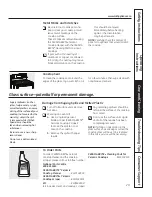
16
Co
ns
um
er
S
up
po
rt
Tr
ou
bl
es
ho
ot
in
g
Ti
ps
Ca
re
a
nd
C
le
an
in
g
O
pe
ra
tin
g
In
st
ru
ct
io
ns
Sa
fe
ty
In
st
ru
ct
io
ns
below. Refer to the Cooking Guide section for recommendations for specific foods. Remember, your new oven
may perform differently than the oven it is replacing.
Baking and Roasting Modes
Select a mode for baking and roasting based on the
type and quantity of food you are preparing. When
preparing baked goods such as cakes, cookies, and
pastries always preheat the oven first. Follow recipe
recommendations for food placement. If no guidelines
are provided, center food in the oven.
Traditional Bake
The traditional bake mode is intended for single rack
cooking. This mode uses heat primarily from the lower
element but also from the upper element to cook
food. To use this mode press the
Bake
pad, enter
a temperature, and then press
Start
. Preheating is
generally recommended when using this mode.
Convection Bake
multiple racks at the same time. This mode uses heat
primarily from the rear element but also heat from the
upper and lower elements, along with air movement
from the convection fan to enhance cooking evenness.
so it is not necessary to convert the temperature when
multiple racks than what would be expected for a single
rack. To use this mode press the
Convection Bake
pad, enter a temperature, and then press
Start
. Always
preheat when using this mode.
Convection Roast
The Convection Roast mode is intended for roasting
whole cuts of meat on a single rack. This mode uses
heat from the lower, upper, and rear elements along
with air movement from the convection fan to improve
browning and reduce cooking time. It is not necessary to
convert temperature. Check food earlier than the recipe
suggested time when using this mode or use a meat
probe. To use this mode press the
Convection Roast
pad, enter a temperature, and then press
Start
. It is not
necessary to preheat when using this mode.
Broiling Modes
broiling on upper rack positions as placing food closer to
the broil element increases smoking, spattering, and the
possibility of fats igniting. For best performance center
food below the broil heating element.
Try broiling foods that you would normally grill. Adjust
rack positions to adjust the intensity of the heat to the
food. Place foods closer to the broil element when a
seared surface and rare interior is desired. Thicker foods
and foods that need to be cooked through should be
broiled on a rack position farther from the broiler or by
using
Broil Lo.
Cookware
Cookware Guidelines
The material, finish, and size of cookware affect baking
performance.
Dark, coated and dull pans absorb heat more readily
than light, shiny pans. Pans that absorb heat more
readily can result in a browner, crisper, and thicker crust.
If using dark and coated cookware check food earlier
than minimum cook time. If undesirable results are
obtained with this type of cookware consider reducing
oven temperature by 25º F next time.
Shiny pans can produce more evenly cooked baked
goods such as cakes and cookies.
Glass and ceramic pans heat slowly but retain heat well.
These types of pans work well for dishes such as pies
and custards.
Air insulated pans heat slowly and can reduce bottom
browning.
Cooking Modes
CAUTION:
Do not use any type of foil or oven liner to cover the oven bottom. These items can trap
heat or melt, resulting in damage to the product and risk of shock, smoke or fire. Damage from improper use
of these items is not covered by the product warranty.
Foil may be used to catch spills by placing a sheet on a lower rack, several inches below the food. Do not use more
oven walls to prevent poor heat circulation.
Using Oven
















